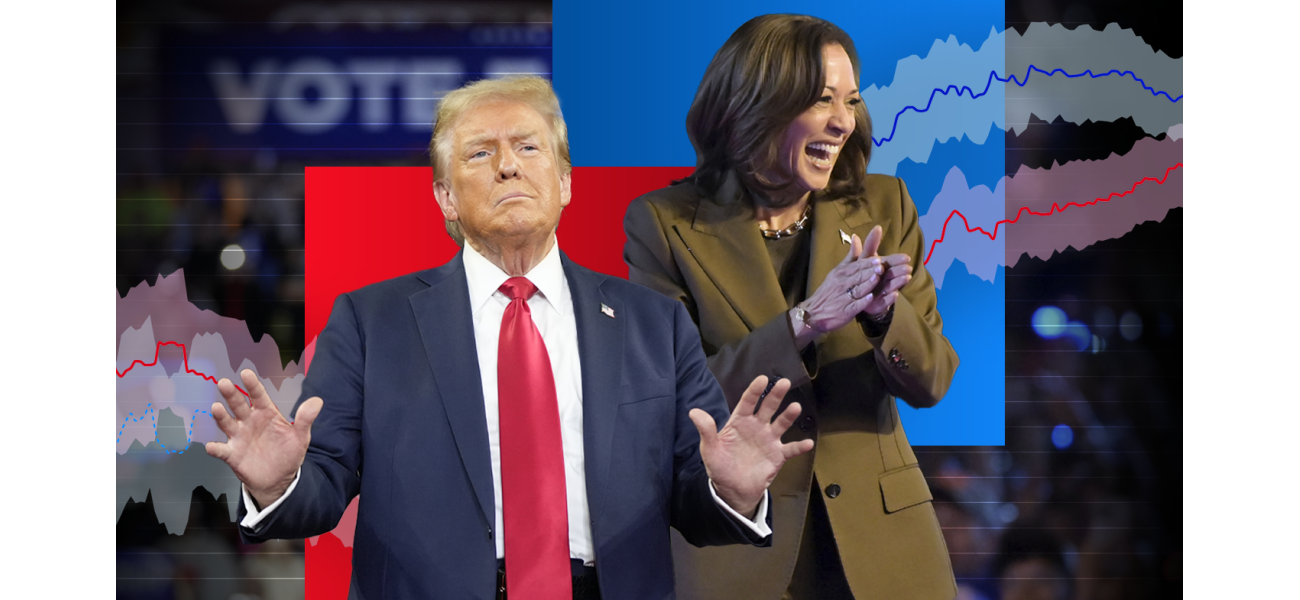Find out who will win the US election on November 5 with our poll-tracker. Track the polls to see who will win the US election on November 5.
In a little more than a week, US citizens will cast their votes for the next president.
November 5th 2024.

After months of campaigning, the time has finally come for Americans to cast their votes and choose their next president. With the election on a knife's edge, all eyes are on the candidates as they make their final push for votes. To keep track of the race, 9News.com.au has created a poll-tracker using data from US polling aggregator FiveThirtyEight.
The tracker gives a nationwide view of the race between Donald Trump and Kamala Harris, giving a sense of how things are going. While the gap between the two has closed nationally, it is still hard to determine who is leading in the crucial swing states. These seven states - Pennsylvania, Wisconsin, Michigan, Georgia, North Carolina, Arizona, and Nevada - will ultimately decide the outcome of the election.
For the people living in these states, the election has been overwhelming. They have been bombarded with campaign ads and rallies, while those living in other states have barely seen any coverage. As a result, it is difficult to predict who will come out on top. Polls have shown the race to be extremely close, with neither candidate consistently ahead by more than two points. And in presidential elections, polls are typically off by about four points.
This means that although the race appears to be a tight one, there is a possibility that one of the candidates could win by a comfortable margin. However, it is more likely that we will not have a clear winner on Election Night, which falls on Wednesday for those in Australia. In fact, it may take several days to count all the ballots and determine the winner.
One of the most striking things about this election is how little the polls have changed in the past month. Normally, there is more fluctuation as one candidate has a great moment or the other has a terrible one. But this year, things have been remarkably stable. This can be attributed to the fact that many undecided voters do not keep up with the news, so scandals that would have previously derailed a candidate have not seemed to affect Trump.
Speaking of polls, they are not an exact science. Like a weather forecast, they are essentially predicting the future. Pollsters ask a sample of people how they plan to vote, and then extrapolate the results for the entire electorate. However, in the United States, voting is not compulsory like it is in Australia. This means that even if someone says they will vote, they may ultimately decide not to. This complicates the accuracy of polls.
It is also important to note that a nationwide poll does not necessarily reflect the outcome of the election. Each state has its own unique demographics and voting patterns. For example, in crucial swing states like Wisconsin, Michigan, and Pennsylvania, Harris currently has the edge. If she wins all three of these states, she will become the next president. However, if she loses just one of them, she will fall short. On the other hand, Trump is currently leading in Georgia, North Carolina, and Arizona, and he will likely need all three of those states to have a chance at winning.
Both candidates have their usual bases of support among different demographic groups. Older voters tend to lean conservative, while younger voters are more likely to vote liberal. Black, Latino, and Asian voters tend to vote for Democrats, while Republicans typically have the edge among white voters. However, the demographics have shifted somewhat this year. Republicans have lost support among college-educated voters, while Democrats are gaining ground among women who may have previously voted for Republicans. But Republicans are also trying to court men, especially young men, who are traditionally the most unreliable voters in the US.
As for election day, the first polls will close at 9am AEDT on Wednesday, and the results will start rolling in soon after. However, the early results are from conservative states like Indiana and Kentucky, which will likely be called immediately for Trump. Throughout the day, every state will begin counting their ballots. If the counting is quick and there is a clear winner, the results may be apparent by mid-afternoon in Australia. However, it is more likely that it will take days before a winner is declared. The prevalence of mail-in ballots, which take longer to process and count, may cause a delay in finalizing the results. This was seen in the 2020 election when Trump initially had a lead on election night, but as more mail-in ballots were counted, his lead started to diminish.
Ultimately, election night is not a race to the finish line, but rather a puzzle that needs to be pieced together. The winner is already determined once the polls close in each state, and it will take time to count all the ballots and assemble the pieces to reveal the final outcome.
The tracker gives a nationwide view of the race between Donald Trump and Kamala Harris, giving a sense of how things are going. While the gap between the two has closed nationally, it is still hard to determine who is leading in the crucial swing states. These seven states - Pennsylvania, Wisconsin, Michigan, Georgia, North Carolina, Arizona, and Nevada - will ultimately decide the outcome of the election.
For the people living in these states, the election has been overwhelming. They have been bombarded with campaign ads and rallies, while those living in other states have barely seen any coverage. As a result, it is difficult to predict who will come out on top. Polls have shown the race to be extremely close, with neither candidate consistently ahead by more than two points. And in presidential elections, polls are typically off by about four points.
This means that although the race appears to be a tight one, there is a possibility that one of the candidates could win by a comfortable margin. However, it is more likely that we will not have a clear winner on Election Night, which falls on Wednesday for those in Australia. In fact, it may take several days to count all the ballots and determine the winner.
One of the most striking things about this election is how little the polls have changed in the past month. Normally, there is more fluctuation as one candidate has a great moment or the other has a terrible one. But this year, things have been remarkably stable. This can be attributed to the fact that many undecided voters do not keep up with the news, so scandals that would have previously derailed a candidate have not seemed to affect Trump.
Speaking of polls, they are not an exact science. Like a weather forecast, they are essentially predicting the future. Pollsters ask a sample of people how they plan to vote, and then extrapolate the results for the entire electorate. However, in the United States, voting is not compulsory like it is in Australia. This means that even if someone says they will vote, they may ultimately decide not to. This complicates the accuracy of polls.
It is also important to note that a nationwide poll does not necessarily reflect the outcome of the election. Each state has its own unique demographics and voting patterns. For example, in crucial swing states like Wisconsin, Michigan, and Pennsylvania, Harris currently has the edge. If she wins all three of these states, she will become the next president. However, if she loses just one of them, she will fall short. On the other hand, Trump is currently leading in Georgia, North Carolina, and Arizona, and he will likely need all three of those states to have a chance at winning.
Both candidates have their usual bases of support among different demographic groups. Older voters tend to lean conservative, while younger voters are more likely to vote liberal. Black, Latino, and Asian voters tend to vote for Democrats, while Republicans typically have the edge among white voters. However, the demographics have shifted somewhat this year. Republicans have lost support among college-educated voters, while Democrats are gaining ground among women who may have previously voted for Republicans. But Republicans are also trying to court men, especially young men, who are traditionally the most unreliable voters in the US.
As for election day, the first polls will close at 9am AEDT on Wednesday, and the results will start rolling in soon after. However, the early results are from conservative states like Indiana and Kentucky, which will likely be called immediately for Trump. Throughout the day, every state will begin counting their ballots. If the counting is quick and there is a clear winner, the results may be apparent by mid-afternoon in Australia. However, it is more likely that it will take days before a winner is declared. The prevalence of mail-in ballots, which take longer to process and count, may cause a delay in finalizing the results. This was seen in the 2020 election when Trump initially had a lead on election night, but as more mail-in ballots were counted, his lead started to diminish.
Ultimately, election night is not a race to the finish line, but rather a puzzle that needs to be pieced together. The winner is already determined once the polls close in each state, and it will take time to count all the ballots and assemble the pieces to reveal the final outcome.
[This article has been trending online recently and has been generated with AI. Your feed is customized.]
[Generative AI is experimental.]
0
0
Submit Comment





